An important addition to his oeuvre of a relatively small number of paintings, almost all of them grisailles drawn with the pen on a white ground, known as penschilderijen (pen paintings).
The pen paintings by Van de Velde the Elder are the very best ever made, and he is also the greatest ‘ship draughtsman’ who ever lived.
Foreword by Rob Kattenburg
Introduction by Remmelt Daalder
The pen painting
Key to the main elements in the pen painting
Vantage points
- Willem van de Velde the Elder
- Rembrandt
The City Inn of Amsterdam
A homeward bound East Indiaman
The flute
The water hoy
Dating the pen painting
The pen painting technique
Literature
Acknowledgements
Willem van de Velde the Elder at work in his galliot as an eyewitness at the Battle of scheveningen, the last engagement of the First Anglo-Dutch War. Although Van de Velde the Elder witnessed at least six of the naval battles of the Anglo-Dutch wars, and frequently included a sketch of his galliot in his drawings, he very rarely portrayed himself in his finished pen paintings. In this dramatic picture of the Battle of scheveningen, though, he chose to depict his galliot in a prominent position in the left foreground. He himself can clearly be seen, seated and with pencil in hand, sketching the action.
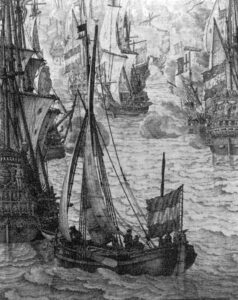
Fig. 5
Willem van de Velde the Elder, at the Battle of scheveningen, 10 August 1653
Detail of fig. 6
The unveiling of a ‘new’, or perhaps I should say previously unknown pen painting by Willem van de Velde the Elder is a special event. It is missing from the major survey of the works of Willem van de Velde, father and son, that Michael s. Robinson published in 1990.1 The View of the IJ from the Old City Inn in Amsterdam, which art dealer Rob Kattenburg discovered in a private collection in the United Kingdom, is even more exceptional for being an early, rare work. It helps to clarify our
still rather hazy view of the first few years of Van de Velde’s career. In addition to being a virtuoso draughtsman he was an artist who occupied a key position in the development of the seascape.
It was probably around 1634 that Willem van de Velde the Elder moved with his wife and child from Leiden to Amsterdam. That child, still a baby, was also called Willem, and would later become famous as the celebrated marine painter Willem van de Velde the Younger. Two years later the equally talented son Adriaen was added to the family. The father, Willem van de Velde the Elder, was a ‘ship draughtsman’, an occupation that offered little security, however virtuoso his drawings were. On top of that, he was not the only one trying to earn a living as a maritime artist at the time. In order to carve out his own niche on the art market he struck out in a new direction. The buzzword nowadays would be ‘innovation’. Van de Velde brought a new kind of artwork onto the market: the maritime pen painting.
This enabled him to offer collectors something that barely existed at the time: a large, durable drawing that could be hung permanently on the wall. It was not entirely new, for Hendrick Goltzius had made several pen paintings at the end
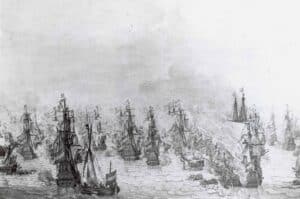
Fig. 6
Willem van de Velde the Elder
The Battle of Scheveningen (Ter Heijde), 10 August 1653
Pen painting on panel, 113.3 x 155.8 cm Inscribed: ‘W.V.Velde A˚ 1655’
Greenwich, National Maritime Museum
of the sixteenth century. Whether Van de Velde knew them is not certain, but he could have read about them in Karel van Mander’s Schilder-boeck. At a certain moment Goltzius switched from vellum to a larger support, as described by Van Mander.
After this Goltzius got the idea of drawing with a pen on canvases primed or prepared with oil paint; for however large the parchments he felt that they were still much too small for his grand intentions and talent. so he did it this way: he drew with the pen on a fairly large prepared canvas.2
Goltzius’s example was mainly followed by marine artists, among them Willem van de Velde the Elder, who is now regarded as the originator of the genre of the maritime pen painting.3 Like Goltzius, he started out with vellum around 1640. Those drawings show what a high standard he could achieve, with amazing details and a refined composition, but it soon became clear, as it had with Goltzius, that he was approaching the limits of the possible. His largest pen drawings on vellum measure roughly 60 x 80 cm He could have used larger sheets, but then there was far more chance that they would contain surface irregularities, which would have ruined the delicacy of
his technique. It was time, in other words, to strike out on a new path, in this case by using the larger support of a panel. That demanded a slightly different technique but had greater potential. It was only the preparatory work that was more laborious. Later, in 1672, the cartographer Pieter Blaeu, an acquaintance of Van de Velde, explained what that involved.
It takes two or three months to prepare, that is to say apply the underlying colour, otherwise the ground isn’t hard enough to take a drawing done with a sharp pen.4
Blaeu was talking about pen paintings on canvas, but the method for panels was largely the same.
The rediscovered View of the IJ from the Old City Inn in Amsterdam dates from the crucial period when Van de Velde made the switch from vellum to panel. He must even have worked briefly on both supports at the same time to meet the demands of clients who preferred vellum. This is demonstrated by another view of the IJ, on vellum, in the collection of the Koninklijk Oudheidkundig Genootschap.5 It is a little smaller than the pen painting now with Kattenburg, but there are so many similarities in the details and composition that is very likely that they were both made at about the same time in the early 1640s.
Willem van de Velde was a businessman as well as an artist. He had a good eye for techniques and opportunities on the art market. In order to drum up new business he was prepared to list everything he could do with a pen, as he once explained to a swedish nobleman whom he was trying to interest in a pen painting.
I can do this [make pen paintings], and have experience in drawing on canvases that can be cleaned and abide water, and in other respects, too, are just as good as a painting.6
That was evidently a strong selling point, cleaning a pen painting with water, just like a painting. Nowadays we would be tempted to add: ‘Don’t try this at home’.
Willem van de Velde was taking a gamble with his innovation. A pen painting not only took a long time to prepare but also to make. Many days of work were needed for even a small panel. That investment could only be recouped through a relatively high price, which in turn could only come from well-to-do clients. Van de Velde evidently managed to find them, but he still only produced a limited number of pen paintings, because his method was so labour-intensive. He was active for almost 60
years, but in that time he made fewer than 100 pen paintings.7 Those from his early period, roughly 1640 to 1650, are really scarce. The same is true of topographical scenes like this view of the IJ, which is why this superb pen painting is such a welcome addition to the artist’s oeuvre.
Dr Remmelt Daalder
Former senior Curator of the scheepvaartmuseum, Amsterdam
1. Michael s. Robinson, Van de Velde: a catalogue of the paintings of the Elder and the Younger Willem van de Velde, 2 vols., London 1990.
2. Karel van Mander, Het Schilder-boeck, Haarlem 1604, fol. 285r.
3. Friso Lammertse, ‘“What one can do with a pen”: pen paintings of maritime scenes’, in Jeroen Giltaij and Jan Kelch (eds.), exhib. cat. Praise of ships and the sea: the Dutch marine painters of the 17th century, Rotterdam (Museum Boijmans Van Beuningen) & Berlin (staatliche Museen zu Berlin) 1996, pp. 45-58, esp. p. 45.
4. Letter from Pieter Blaeu to Cardinal Leopoldo de’ Medici, 1 January 1672, quoted in Remmelt Daalder, Van de Velde & Zoon, zeeschilders: het bedrijf van Willem van de Velde de Oude en Willem van de Velde de Jonge, 1640-1707 (diss.), Amsterdam 2013, p. 146. The English trade edition of this study will be published by Primavera Pers of Leiden in 2015.
5. Willem van de Velde the Elder, View of the IJ looking east, signed ‘w.v.velde’, c. 1645, pen and brush on vellum, 36.5 x 55.3 cm Amsterdam, Koninklijk Oudheidkundig Genootschap, inv. no. KOG-AA-1-02/03-z.n.
6. Daalder, Van de Velde & Zoon, Bijlage 2, p. 235.
7. A calculation of the output of the two Van de Veldes will be found in Daalder, Van de Velde & Zoon, Bijlage 1, pp. 230-233.
Near this Place were Deposited the Remains of
WILLEM VAN DE VELDE THE ELDER
Born in 1610 11 Died in 1693
and of his son
WILLEM VAN DE VELDE THE YOUNGER
Born in 1633 Died in 1707
After the Year 1673
these Eminent Dutch Marine Artists
Lived and Worked in this Country
As Painters of seafights
To Their Majesties
KING CHARLEs THE sECOND
AND KING JAMEs THE sECOND
This Tribute
Alike to their Artistic Merits
To their Faultless Craftsmanship
And to the Historical Value of their Works
through Money Publicly subscribed
was Erected here by
The society for Nautical Research
In the Year 1929
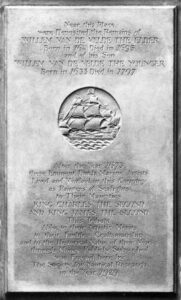
Fig. 7
The memorial stone in st James’s Church, Piccadilly, London, UK
From left to right: Volewijk,
Nieuwendam (barely visible),
Schellingwoude in the middle,
Ransdorp Tower
A homeward bound Dutch East Indiaman off Nieuwendam.
Two water hoys to the right of centre, two flutes on the far right.
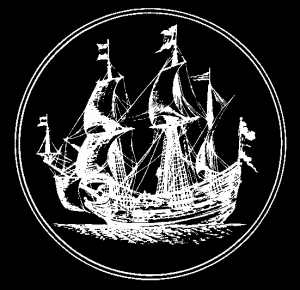

Fig. 2
WILLEM JANsZ BLAEU
HOLLANDIA | COMITATUS.
t’ Graefschap Hollandt. | Van
nieus verbetert ende vermeerdert |
door Willem Ianszoon [ Blaeu].
/ Iosua vanden Ende sculpsit
[map].
Engraving, 36.6 x 48 cm
second state, 1631
Rob Kattenburg Collection
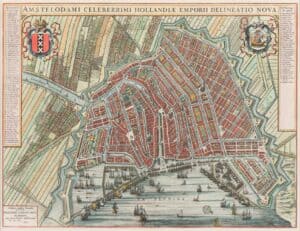
Fig. 3
HONDIUs / BLAEU
AMSTELODAMI
CELEBERRIMI HOLLANDIAE
EMPORII DELINEATIO
NOVA
Engraving, 41 x 53.5 cm
Third state, 1649-1652
Rob Kattenburg Collection
(situation before 1656)
It was forty years ago that we opened our specialist art gallery for Dutch and Flemish maritime paintings, drawings, prints and cartography from the seventeenth to the nineteenth centuries. In that time we have not only bought and sold art but have also published many beautifully illustrated catalogues and brochures,
some of which have contributed new findings to the established art-historical literature.
This specialisation gives our gallery a unique position in the international art trade, with Rob Kattenburg acting as a walking encyclopedia for museum curators and private collectors. In those forty years we have sold dozens of paintings, drawings and prints to museums in the Netherlands and abroad, and we are proud of that. The downside is that those works of art will never come on the market again, so in a sense we have ourselves helped to limit the supply of the very best works.
It has become something of a tradition for us to present a fine and remarkable painting each year. That we are able to do so is due in part to our worldwide contacts with collectors. This year, too, we have a picture that is unique in every way.
AN UNKNOWN PEN PAINTING BY WILLEM VAN DE VELDE THE ELDER
View of the IJ from the Old City Inn in Amsterdam
The artist captured the bustle of the traffic on the water and contrasted it with the still rural landscape in the distance. Plenty of seventeenth-century artists painted Amsterdam with the IJ, but always from the north or north-east, looking towards the city. so it is very odd that Van de Velde chose to show the opposite view. The highly detailed execution and value as a topographical document make this an important work in the oeuvre of this famous seventeenth-century master.
I mentioned that it is becoming more and more difficult to acquire good paintings. Buying at auction has become almost prohibitive due to the ever-increasing premiums, the amount that the auction house charges the buyer over and above the hammer price. sometimes, though, one can still make interesting acquisitions at sales like that as a result of an incorrect attribution, for instance. Although it is very time-consuming to keep track of national and international auctions, it is becoming ever more important to buy not at auction but directly from private collectors. Thanks to all these efforts we have again succeeded in putting an interesting collection together for 2015.
We have met many people in the past four decades: collectors of every kind, museum curators, historians and art historians, some of whom have became friends as well as clients. They, too, have helped make our gallery a success, and I am deeply grateful to them. In conclusion, I would like to thank Dr Remmelt Daalder, maritime historian and former curator of the Nederlands scheepvaartmuseum, for his willingness to write the introduction to this publication.
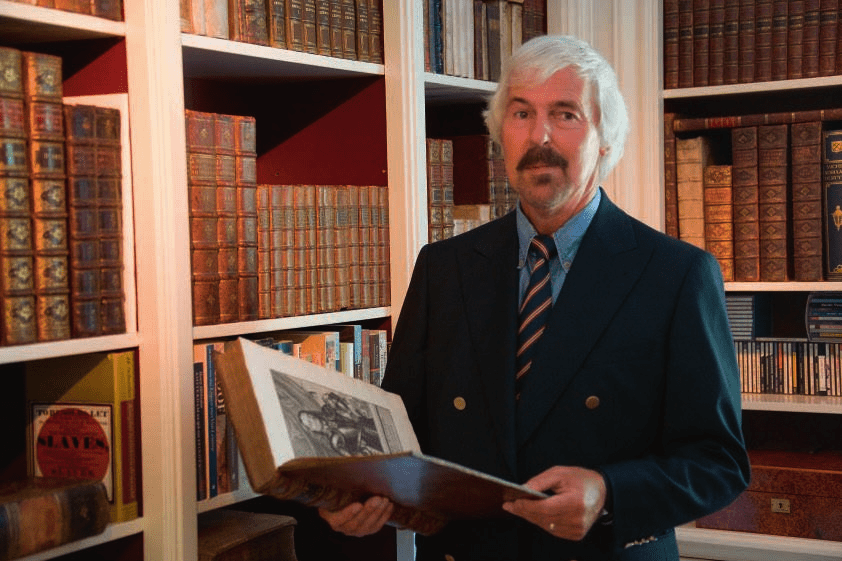
Fig. 4
Rob Kattenburg in his library, holding a copy of Gerard Brandt, Het leven en bedrijf van de Heere Michiel de Ruyter, Amsterdam 1687.
I. Volewyck
II. Nieuwendam (barely visible)
III. The village of schellingwoude
IV. Ransdorp Tower
V. A homeward bound Dutch East Indiaman
VI. Two water hoys
VII. Two flutes
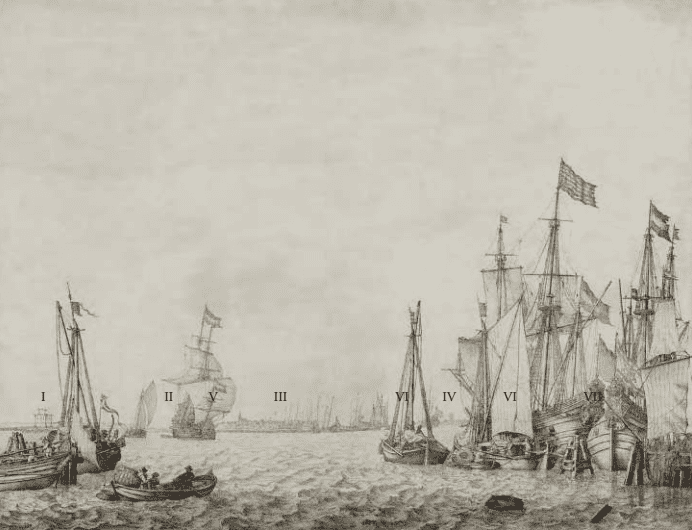
Fig. 9
View of the IJ from the Old City Inn in Amsterdam
(see fig. 8)
- Willem van de Velde the Elder (VIII)
- Rembrandt (IX)
The positions that the two artists took up are shown in the detail of the map of North Holland below. They were in an area that provided a good view of the far shore of the IJ. Rembrandt was looking due north, Willem van de Velde north-east. The latter’s depiction is a rare historical document, since artists usually preferred the opposite view, looking towards Amsterdam.
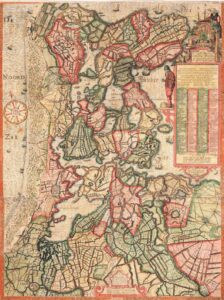
Fig. 10
Joost Jansz Beeldsnijder
Land caerte ende water caerte van Noort Hollandt ende West-Vrieslandt met
d’aenliggende landen
Engraving, 93.7 x 70.3 cm
second state, 1608
scale: 1:100,000
Beeldbank Noord-Hollands Archief
Collectie Provinciale Atlas - Kaarten en kaartboeken, photo no. 2436.

Fig. 11, Detail of fig. 10
The Old City Inn stood on piles in the IJ opposite the entrance to Herengracht.
One stretch of the fortifications of Amsterdam consisted of a double row of posts in the IJ open at various points to allow boats to pass through. The openings in the palisade were closed off at sunset with iron-clad wooden booms, apart from the one in front of the inn, which stayed open until 21.30. East Indiamen berthed at the palisade. There was another row of posts from Volewijk to Nieuwendam on the far side of the IJ.
The original inn was renamed the Old City Inn when the second one was built in 1661.

Fig. 14
Anonymous artist
Amsterdam
1623-1626
Pen in brown, brush in colour, 32.6 x 47.7 cm
Amsterdam City Archives, inv. no. 10035/406
Viewpoint of Willem van de Velde the Elder, looking north-east from the Old City Inn of Amsterdam.

Fig. 16
C.J. Visscher
Skyline of Amsterdam seen from the IJ, c. 1650
Etching on four sheets, 41.6 x 215 cm
Rob Kattenburg Collection
© 2022 Rob Kattenburg
Website Mediya.nl